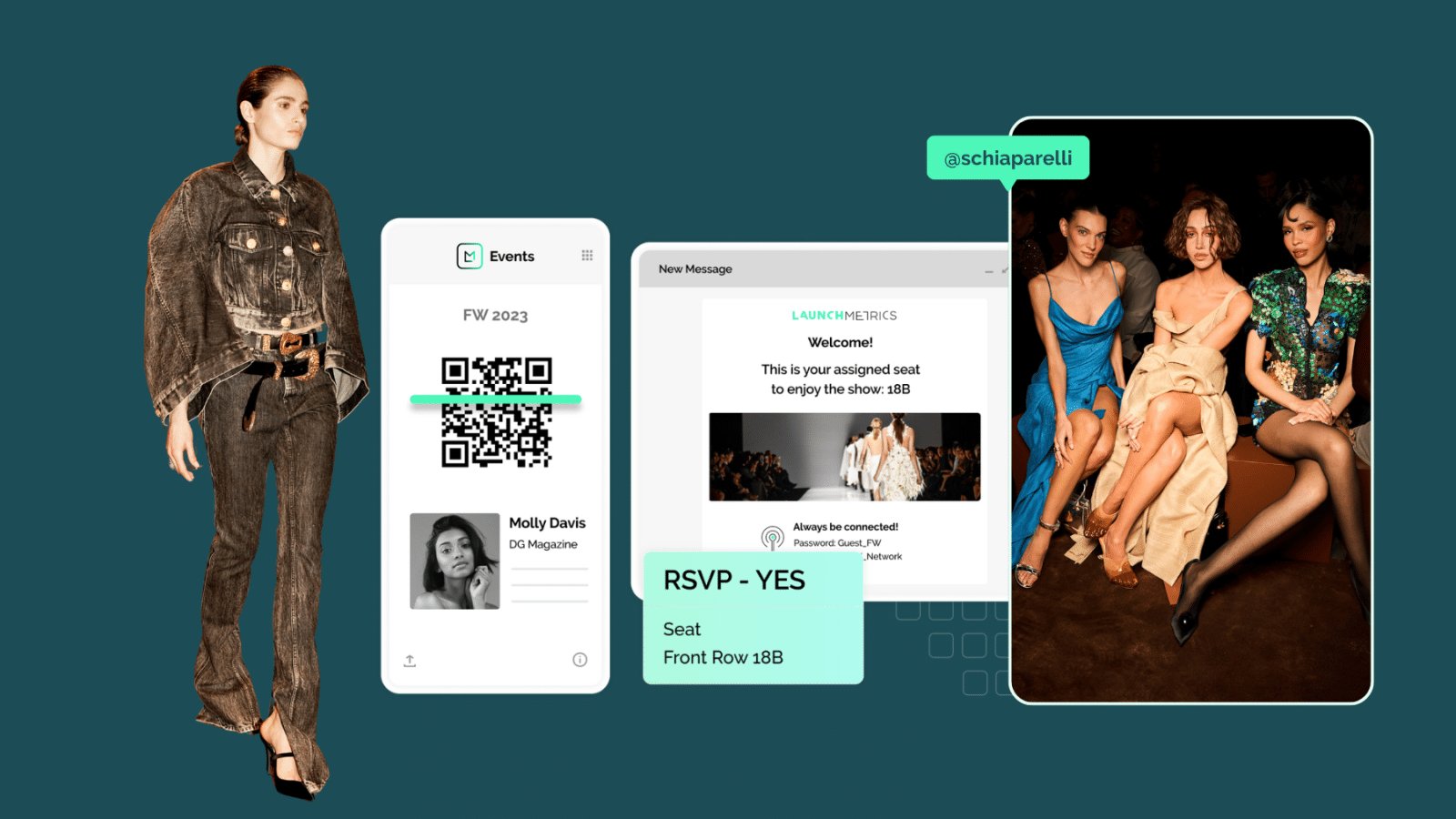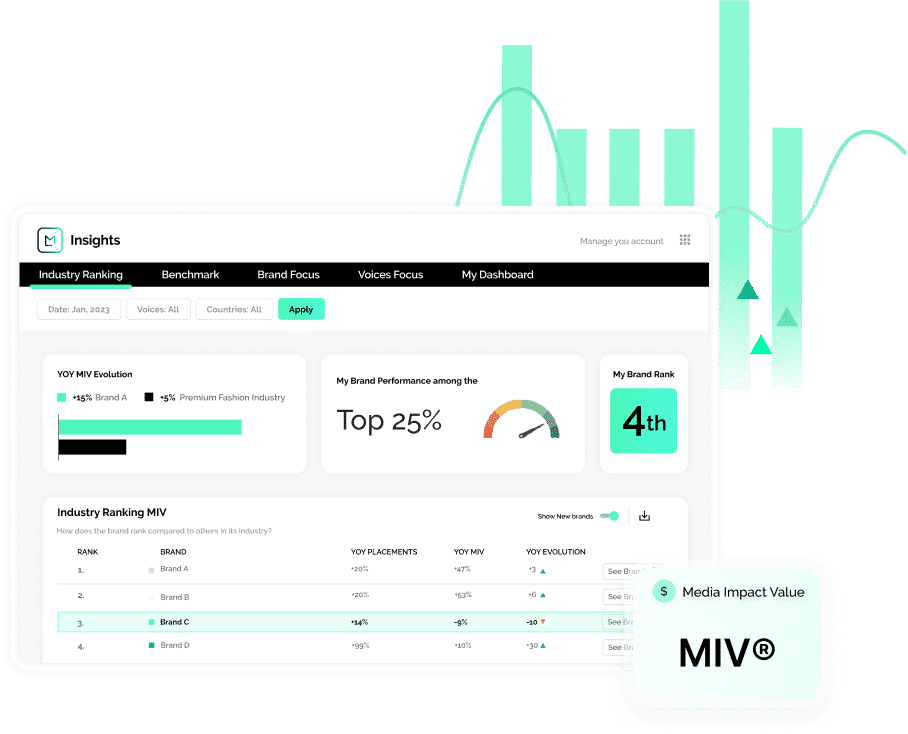Fashion week shows are one of the biggest investments a brand can make. From runway production and PR outreach to influencer partnerships and sample sendouts, the costs add up quickly. But how do you know if your investment paid off?
Success isn’t just about who attended your show or how many posts featured your collection—it’s about the measurable impact your brand achieves, not only during the event but also in the months that follow. Generating buzz in real time is crucial, but sustaining that momentum long after Fashion Week is what truly extends the value of your investment.
Did your event create the right kind of buzz? Which voices generated the most value? How does your performance compare to competitors? Most importantly, how effectively did you capitalize on post-show momentum to maximize exposure and engagement? These are the key questions that must be answered to optimize your strategy and ensure long-term success.
Below, we’ll break down the key steps you need to take to assess your brand’s performance and identify opportunities for improvement so you can continue to drive value from every fashion week event.
5 Steps to Measure Your Fashion Month Performance & Maximize Post-Show Impact
1. Analyze Event Attendance to Inform Future Strategies
So your venue was packed to the rafters with stylish attendees. That’s a good sign people are interested in your brand, but attendance alone doesn’t tell the full story. To truly understand the impact of your fashion week event, you need to go beyond the headcount and analyze the quality of your attendees. Were the right press, buyers and influencers present? Did they engage with your brand in a meaningful way? These insights are crucial for refining your strategy and ensuring that future events attract the right audience.
Event management software like Launchmetrics Events allows you to track and measure your event’s success with real-time metrics. You can easily analyze who RSVP’d versus who actually attended, which is helpful on several fronts. Firstly, you can follow up with no-shows by sending post-show images, press releases and other materials, giving them the opportunity to still engage with your collection despite missing the event. Secondly, tracking attendance patterns over multiple events helps you fine-tune your guest list and improve planning for future shows.

Step 2 - Analyze Coverage and Identify Highest-Performing Voices
Every brand wants their show to be the talk of the town, but how do you truly analyze the coverage you get? The thing is, not all coverage carries the same weight. One post from an All-Star Influencer might be worth five Mid-Tier Influencer posts—or it might not, depending on factors like how engaged their audience is and the quality of the post itself.
This is where using the right metrics is critical. You need to know the true impact of the media mentions you achieved, as well as which Voices at your show brought you the highest return on investment. Tracking the number of times your brand was mentioned or even calculating reach isn’t enough—none of that will give you a complete picture of your event’s impact.
One standardized metric that helps quantify media exposure is Media Impact Value® (MIV®). MIV assigns a monetary value to editorial and social media placements, allowing brands to measure the financial worth of their earned media coverage. This metric considers factors like publication authority, audience reach, engagement levels and the credibility of the source. By analyzing MIV, brands can distinguish between high-impact mentions from leading publications and lower-value placements with minimal audience engagement.
MIV also helps you understand who your highest-performing Voices are. Remember that there are five key Voices driving the customer journey: Celebrities, Influencers, Media, Owned Media and Partners. Knowing how each of these performed during your fashion week campaign is instrumental for optimizing future events. For example, you might discover that your Owned Media accounts have a much higher potential for driving value than you initially thought, or that a certain mix of Influencer tiers provides the ideal balance for reach and conversion.
Let’s also not forget that, these days, the ripples of a fashion show’s buzz go far beyond what the physical attendees are saying about it. For example, a single post from a celebrity guest can be amplified by major media outlets, or a style Influencer watching the livestream—without even being invited—can unexpectedly create a high-value post. This is why a tool like Launchmetrics Discover is invaluable: it tracks coverage across more than 8K+ print titles, 2M+ online articles and 1.2M+ social accounts, ensuring that no mention goes unnoticed. On top of that—and most crucially—you can filter mentions by platform, channel, region and more to give you a detailed picture of your event’s impact.
Once you’ve analyzed your coverage and identified the top-performing Voices, you’ll have some invaluable data-based insights at your fingertips that can be used to optimize your marketing budget and inform future fashion week campaigns.
Step 3 - Benchmark Against Competitors To Gain a Holistic View of Performance
Now that you know what people have been saying about your show and which Voices brought you the most value, it’s time to add another layer of data-driven analysis. For a truly holistic view of your brand’s performance, let’s see how you stack up against competitors.
Comparative benchmarking allows you to measure your Share of Voice—a key metric that indicates how much attention your brand received relative to others in the industry. This can help you determine whether your PR efforts cut through the noise during fashion week or if competitors dominated the conversation.
Using a data insights tool like Launchmetrics Insights, you can track your brand’s performance in real time and benchmark it against competitors. Using MIV as a metric, Insights allows you to compare your brand’s marketing performance directly with that of competing brands during a given time period. On top of that, a visual scoreboard allows you to track your brand’s evolution over time in relation to competitors.
Beyond numbers, competitive benchmarking helps you identify emerging trends and key players in your category. Did a competitor’s innovative show format generate more buzz? Was their influencer strategy more effective? By examining these insights, you can refine your approach for future events.
For example, our Spring/Summer 2025 Fashion Week Data and Insights report highlights the success of S.S. Daley’s London Fashion Week debut, which gained a whopping 96% of MIV through the Media Voice. Why? Closer inspection of the data shows that Harry Styles’ front row attendance was responsible for 70% of the media mentions—including the top placement in British Vogue that drove $379K in Media Impact Value. These types of insights can be extremely valuable for brands as they establish their own marketing strategies.
Voice Mix of S.S. Daley during the London Fashion Week SS25 period.
Finally, competitive benchmarking helps optimize resource allocation. If certain media outlets or Influencers drove high engagement for a competitor, it may be worth considering them for future collaborations. On the other hand, if a competitor's campaign underperformed in a specific area, it could signal an opportunity for your brand to capitalize on a gap in the market.
As you can see, knowing where you stand in the competitive landscape is another crucial aspect of post-fashion month reporting that can help your brand justify its investment and gain an edge in future events.
Step 4 - Manage Samples Sendouts Seamlessly and Maximize Coverage on Each Sample
The runway show might be over, but the buzz around your collection shouldn’t stop there. To maximize media exposure, you need to ensure samples are sent to the right people at the right time. A well-organized sample management strategy can help your brand secure top-tier editorial placements, influencer partnerships and retailer buy-ins.
If you’ve ever handled sample sendouts manually, you’d know that it’s a headache. It’s time-consuming and often results in costly errors. Requests can overlap—an editor needs a look for a shoot, while a celebrity stylist requests the same piece for a red carpet event. You scramble to keep track, only to realize a key item was sent to the wrong place or you missed an opportunity entirely. Dates get mixed up, samples go missing and suddenly your brand isn’t taking full advantage of the momentum your show created.
This is why using a dedicated sample management tool like Launchmetrics Samples is essential. This platform streamlines the entire process, allowing brands to track sample requests, monitor returns and oversee the status of every item in real time. With Samples, your PR team can ensure that every editor, influencer and stylist gets the pieces they want when they want them, minimizing delays and lost inventory—and maximizing coverage.
Additionally, having a centralized system for sample management allows brands to track which placements have been the most impactful. For instance, maybe a particular sample resulted in a high-profile magazine feature, or an influencer’s styling of a piece generated a high level of social media buzz. By analyzing coverage generated from sample placements, brands can make more data-driven decisions about future sample allocations and optimize their outreach strategies.
This step is important because no event or campaign happens in isolation—every activation contributes to your broader brand-building and business objectives. So, it’s important to have your assets working for you long after the curtains close on the runway. By strategically managing sample sendouts, you can extend your collection’s visibility and keep your brand top of mind well beyond fashion month.
Step 5 - Automate Reporting With One Unified Brand Performance Cloud To Assess the Success of the Season
After the frenzy of Fashion Month, it’s crucial to assess results in a clear, organized way. However, compiling and analyzing data manually is time-consuming and inefficient. Without a structured system, brands risk overlooking key insights that could inform future strategies and help them get ahead.
This is where you need to leverage technology and automate your reporting. Using a tool like Launchmetrics’ Brand Performance Cloud, brands can:
- Automate performance reporting to track the success of PR and media coverage with minimal effort.
- Gain real-time insights into which strategies worked best, allowing for agile decision-making for future campaigns.
- Streamline internal reporting to ensure that teams have easy access to the data they need to refine upcoming brand activations.
Life for PR and marketing teams is much easier when they can access data-driven insights at a glance. These insights allow them to stay ahead of trends, refine their fashion week strategies and keep the momentum going long after the event is over.
How is your brand positioned now that Fashion Month has closed down the runways for another season? Now is the time to refine your PR strategy using all the insights you can glean and to amplify your press coverage to maximize your ROI. By following the checklist above, you can ensure your next big event translates into long-term brand success.

